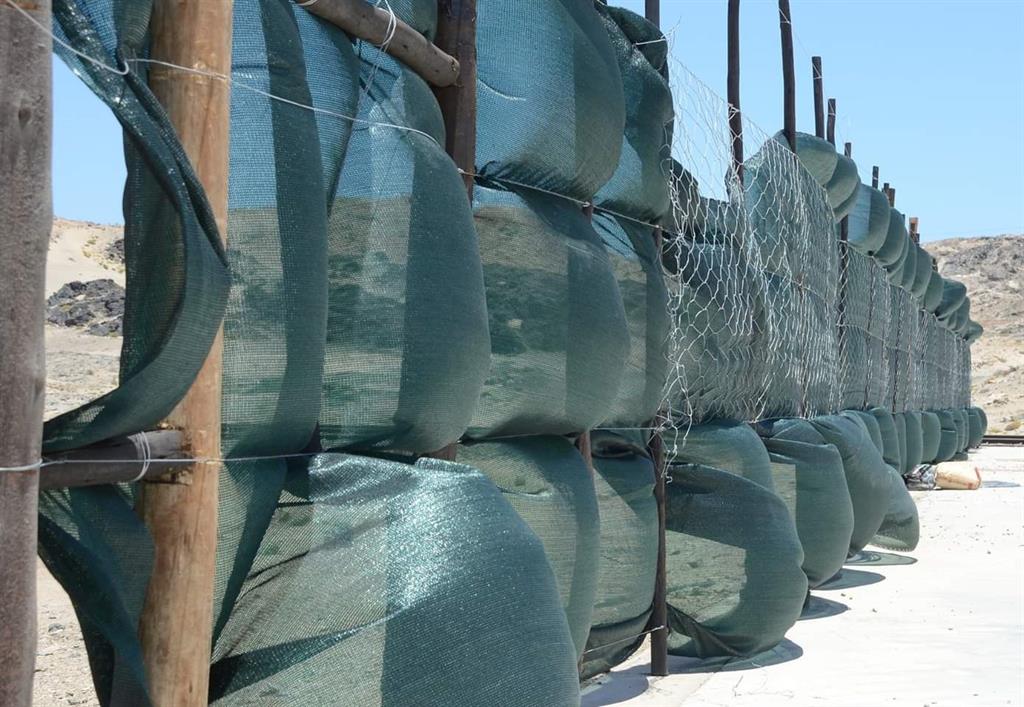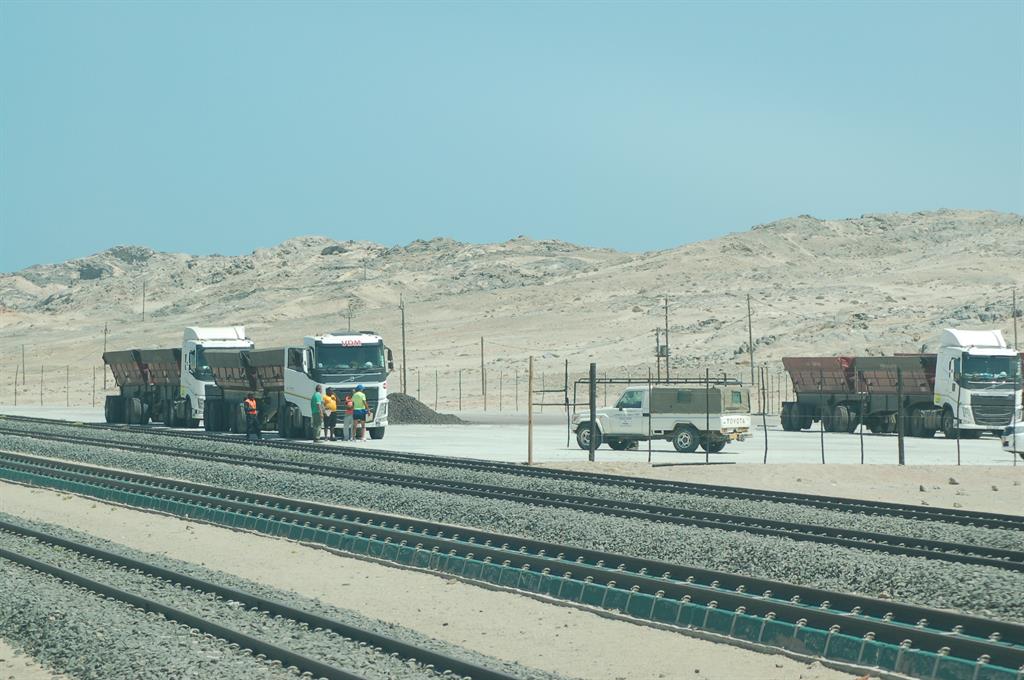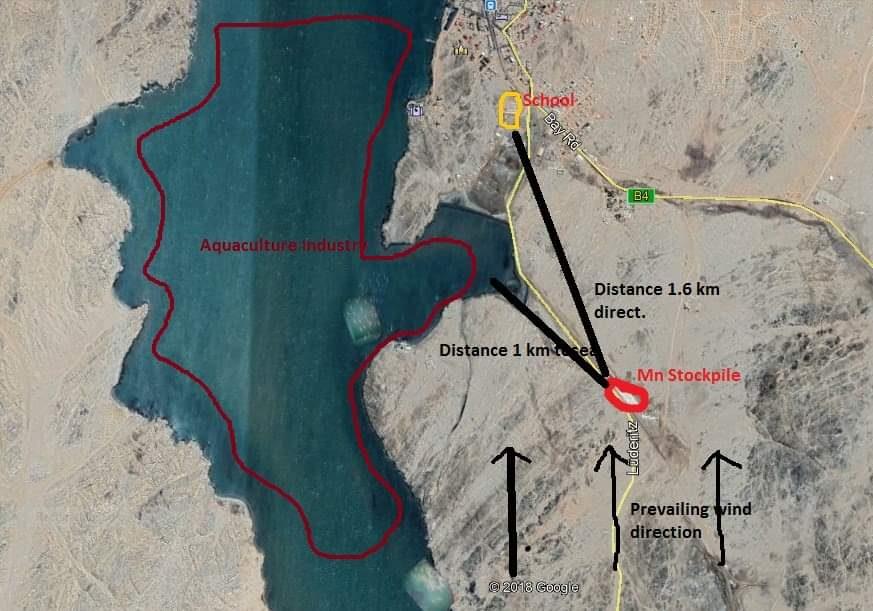Battle for Lüderitz is on
The trans-shipment of large volumes of South African manganese ore via Lüderitz is said to threaten the town's future.
The acting permanent secretary of the ministry of environment and tourism, Teofilus Nghitila, yesterday confirmed that no environmental clearance certificates had been issued to two South African companies to export manganese ore via the port of Lüderitz.
Nghitila has instructed an investigation into the matter.
Lüderitz residents had a rude awakening at the end of 2018 when trucks rolled in and dumped a large heap of manganese ore just outside the town.
The ore was brought in by a South African company, registered here as TradePort Namibia CC, one of two companies that have been in negotiations with NamPort for the handling and exporting of manganese to China.
Local people charged that the manganese was “dumped” without TradePort having secured an environmental clearance certificate, something which could not yet be established.
But that confirmed their worst fears for the town's future.
The first evidence of the goings-on was when workers put up a fence made of wooden poles, steel wire and shade netting around three corners of a concrete slab next to the rail siding about 600 metres south-southwest of the town.
Residents say this site is in the direct path of the prevailing southwesterly winds, which often reach 40 to 50 knots, blowing directly into the lagoon and over the town.
Offloading started on 1 January and the observers noted that by late afternoon on the same day plumes of black dust could clearly be seen moving rapidly along with the wind towards the town.
The operations had been slated to start between January and March, pending official approval.
Background
The observers said news of the impending handling and exporting of the manganese ore through the Lüderitz port only emerged during November – in newspaper advertisements which many had missed – and a stakeholders' meeting on 3 December.
When some details of the planned operations were revealed at the stakeholders' meeting, grave concerns were expressed that this could sound the death knell for local businesses and potentially smother the windswept town in a toxic coat of black dust.
At that meeting it became clear that NamPort was finalising deals with TradePort and the other South African company, registered here as Pektranam Logistics, to ship 30 000 tonnes of manganese ore per month from each of the companies via the Lüderitz port.
These volumes could increase in future.
Pektranam Logistics, which hosted the stakeholders' meeting, said it would use 834 truckloads for one shipment of 30 000 tonnes per month. It said the loads would be distributed over a 30-day period. Each truck should deliver about 12 loads; it will therefore use 70 trucks per shipment.
The distribution of the loads will mean a frequency rate of 1.16 trucks per hour, or one truck every 52 minutes over a 24-hour period, offloading the ore at the site of the old Roads Construction Company (RCC) camp about two kilometres outside Lüderitz.
A co-owner and director of the family-owned Kuruman-based company, Pieter Kruger, said the stockpiled manganese would be moved to the harbour over a three-day period every month, with ten dedicated trucks moving through the town when the ships come in.
TradePort's draft environmental scoping document only states that once the manganese ore is being offloaded on the concrete slab, five trucks with link trailers will run 24 hours per day to the NamPort jetty until a ship is loaded.
It does not state how many trucks will run between the Ariamsvlei border post and Lüderitz, or to what extent it intends to use rail.
Be that as it may, the residents complained that this would not only disrupt traffic in the town's main street, but also transport more dust directly through the town.
Heavy-duty trucks from Rosh Pinah and Scorpion Zinc are already driving through the town every ten minutes, every day of the week, to offload sulphur and zinc at the NamPort jetty.
'NOT PAST MY FRONT DOOR!'
Residents are livid about the truck volumes, saying turning this narrow street into a “highway of trucks operating on a 24/7 basis” will bring all traffic to a standstill and cause serious damage to the road infrastructure.
Lüderitz is a small town hemmed in by mining areas, the Naukluft Park and the recently proclaimed Sperrgebiet Park. It has a 41-kilometre coastal area.
It is considered a cul de sac destination with only one way in and out. There are no alternative routes and the main street is where most businesses are clustered.
Trucks using this street would also disrupt business in the town centre and severely affect tourism, which has shown steady growth over the last ten years.
More importantly, contamination would harm the marine aquaculture (or mariculture) and fishing sectors that keep Lüderitz afloat.
“We are not against economic development, but at what cost does this come? What is the benefit to Lüderitz? If the environment gets contaminated with that dust you cannot reverse it; there is no recourse,” said Howard Head, involved in marine diamond recovery and local tourism.
Jason Burgess, involved in oyster farming, said the location of the ore stockpile is a major worry. The site is in a wind funnel which blows directly onto the first lagoon with its oyster and abalone farms.
Burgess points out that oysters, as filter-feeders, are a primary indicator species and can be negatively affected by any manganese dust entering the water.
Mariculture in Lüderitz is currently thriving because the seawater is clean.
“The lagoon is the catch-point for all the dust before it even gets to town. That is also the primary swimming area; where will our children swim? What will be the future of our children that will be exposed to that?” Burgess said.
CEO of Marco Fishing, Kurt Laufe, believes the manganese business would jeopardise the fishing industry because the truck traffic would block the entrance to the harbour.
More importantly, Laufe said the local fishing companies export fresh fish to the European Union.
“Can you imagine if there is just a little plume of manganese [dust] coming through the air and it settles on the fish? It would destroy the entire fishing industry,” Laufe said.
Ulf Grünewald, chairperson of the Lüderitz Tourism Forum and general manager at the Nest Hotel, feels that more should instead be invested on creating “clean” and alternative development.
WHY LÜDERITZ?
Residents also want to know why the two South African companies decided to move their manganese ore through Lüderitz while there are huge ports in South Africa.
Media reports in South Africa suggest that there were outcries and protests over manganese dust pollution at the Port Elizabeth port.
Kruger said it is simple: the distance between Lüderitz and other South African ports from the Kuruman area is practically the same, the region is thinly populated, and the topography is flat as opposed to the mountainous and densely populated other routes.
Also, he said, NamPort was forced to drastically reduce its port tariffs to be competitive. This massive tariff reduction was only conceded to the manganese projects.
HEALTH MATTERS
There are also numerous reports of the health hazards of exposure to manganese dust. One of these is 'manganism', an occupational disease similar to Parkinson's disease.
Pektranam's owners insist that there cannot be any hazardous effects, arguing that manganese only becomes a health risk when it is being processed.
Assmang Manganese – one of the oldest and biggest manganese mining operations in South Africa – is a main supplier of the manganese ore to Pektranam.
Monde Gwababa, a hygiene officer at Assmang Manganese, assured Pektranam in an email that “manganese dust poses a risk of manganese poisoning”, but added that this “normally can occur after variable heavy exposure ranging from six months to three years at average air levels of 1 mg/m3 [one milligram per cubic metre].”
“[At] our operations the exposure levels are fairly low and even in Port Elizabeth harbour where we also export our manganese ore the levels in the air are of insignificant risk,” Gwababa wrote.
Pektranam insisted the manganese ore is like hard rock. It said each load will contain about 27% to 37% of this rock-like ore, but contended that the rest of the load is “ordinary soil and gravel”.
'IT'S MANAGEABLE, NOT SO BAD'
NamPort has proactively gone out to lure more business to its Lüderitz port, which according to a NamPort official is currently only busy for about two weeks a month.
“We can handle the volumes,” said this official, who preferred anonymity.
He added that there was “no way” NamPort would touch a product that was not cleared for shipment.
Crispin Clay of the Lüderitzbucht Foundation is adamant that an urgent moratorium be placed on the manganese trans-shipment and all such projects that could pose a risk to “our country, our people, our resources, our environment”.
Preferably, he said, these should be stopped permanently, at least until comprehensive, independent, internationally credible scientific studies have been completed, assessed and agreed on by all parties involved.
Nghitila has instructed an investigation into the matter.
Lüderitz residents had a rude awakening at the end of 2018 when trucks rolled in and dumped a large heap of manganese ore just outside the town.
The ore was brought in by a South African company, registered here as TradePort Namibia CC, one of two companies that have been in negotiations with NamPort for the handling and exporting of manganese to China.
Local people charged that the manganese was “dumped” without TradePort having secured an environmental clearance certificate, something which could not yet be established.
But that confirmed their worst fears for the town's future.
The first evidence of the goings-on was when workers put up a fence made of wooden poles, steel wire and shade netting around three corners of a concrete slab next to the rail siding about 600 metres south-southwest of the town.
Residents say this site is in the direct path of the prevailing southwesterly winds, which often reach 40 to 50 knots, blowing directly into the lagoon and over the town.
Offloading started on 1 January and the observers noted that by late afternoon on the same day plumes of black dust could clearly be seen moving rapidly along with the wind towards the town.
The operations had been slated to start between January and March, pending official approval.
Background
The observers said news of the impending handling and exporting of the manganese ore through the Lüderitz port only emerged during November – in newspaper advertisements which many had missed – and a stakeholders' meeting on 3 December.
When some details of the planned operations were revealed at the stakeholders' meeting, grave concerns were expressed that this could sound the death knell for local businesses and potentially smother the windswept town in a toxic coat of black dust.
At that meeting it became clear that NamPort was finalising deals with TradePort and the other South African company, registered here as Pektranam Logistics, to ship 30 000 tonnes of manganese ore per month from each of the companies via the Lüderitz port.
These volumes could increase in future.
Pektranam Logistics, which hosted the stakeholders' meeting, said it would use 834 truckloads for one shipment of 30 000 tonnes per month. It said the loads would be distributed over a 30-day period. Each truck should deliver about 12 loads; it will therefore use 70 trucks per shipment.
The distribution of the loads will mean a frequency rate of 1.16 trucks per hour, or one truck every 52 minutes over a 24-hour period, offloading the ore at the site of the old Roads Construction Company (RCC) camp about two kilometres outside Lüderitz.
A co-owner and director of the family-owned Kuruman-based company, Pieter Kruger, said the stockpiled manganese would be moved to the harbour over a three-day period every month, with ten dedicated trucks moving through the town when the ships come in.
TradePort's draft environmental scoping document only states that once the manganese ore is being offloaded on the concrete slab, five trucks with link trailers will run 24 hours per day to the NamPort jetty until a ship is loaded.
It does not state how many trucks will run between the Ariamsvlei border post and Lüderitz, or to what extent it intends to use rail.
Be that as it may, the residents complained that this would not only disrupt traffic in the town's main street, but also transport more dust directly through the town.
Heavy-duty trucks from Rosh Pinah and Scorpion Zinc are already driving through the town every ten minutes, every day of the week, to offload sulphur and zinc at the NamPort jetty.
'NOT PAST MY FRONT DOOR!'
Residents are livid about the truck volumes, saying turning this narrow street into a “highway of trucks operating on a 24/7 basis” will bring all traffic to a standstill and cause serious damage to the road infrastructure.
Lüderitz is a small town hemmed in by mining areas, the Naukluft Park and the recently proclaimed Sperrgebiet Park. It has a 41-kilometre coastal area.
It is considered a cul de sac destination with only one way in and out. There are no alternative routes and the main street is where most businesses are clustered.
Trucks using this street would also disrupt business in the town centre and severely affect tourism, which has shown steady growth over the last ten years.
More importantly, contamination would harm the marine aquaculture (or mariculture) and fishing sectors that keep Lüderitz afloat.
“We are not against economic development, but at what cost does this come? What is the benefit to Lüderitz? If the environment gets contaminated with that dust you cannot reverse it; there is no recourse,” said Howard Head, involved in marine diamond recovery and local tourism.
Jason Burgess, involved in oyster farming, said the location of the ore stockpile is a major worry. The site is in a wind funnel which blows directly onto the first lagoon with its oyster and abalone farms.
Burgess points out that oysters, as filter-feeders, are a primary indicator species and can be negatively affected by any manganese dust entering the water.
Mariculture in Lüderitz is currently thriving because the seawater is clean.
“The lagoon is the catch-point for all the dust before it even gets to town. That is also the primary swimming area; where will our children swim? What will be the future of our children that will be exposed to that?” Burgess said.
CEO of Marco Fishing, Kurt Laufe, believes the manganese business would jeopardise the fishing industry because the truck traffic would block the entrance to the harbour.
More importantly, Laufe said the local fishing companies export fresh fish to the European Union.
“Can you imagine if there is just a little plume of manganese [dust] coming through the air and it settles on the fish? It would destroy the entire fishing industry,” Laufe said.
Ulf Grünewald, chairperson of the Lüderitz Tourism Forum and general manager at the Nest Hotel, feels that more should instead be invested on creating “clean” and alternative development.
WHY LÜDERITZ?
Residents also want to know why the two South African companies decided to move their manganese ore through Lüderitz while there are huge ports in South Africa.
Media reports in South Africa suggest that there were outcries and protests over manganese dust pollution at the Port Elizabeth port.
Kruger said it is simple: the distance between Lüderitz and other South African ports from the Kuruman area is practically the same, the region is thinly populated, and the topography is flat as opposed to the mountainous and densely populated other routes.
Also, he said, NamPort was forced to drastically reduce its port tariffs to be competitive. This massive tariff reduction was only conceded to the manganese projects.
HEALTH MATTERS
There are also numerous reports of the health hazards of exposure to manganese dust. One of these is 'manganism', an occupational disease similar to Parkinson's disease.
Pektranam's owners insist that there cannot be any hazardous effects, arguing that manganese only becomes a health risk when it is being processed.
Assmang Manganese – one of the oldest and biggest manganese mining operations in South Africa – is a main supplier of the manganese ore to Pektranam.
Monde Gwababa, a hygiene officer at Assmang Manganese, assured Pektranam in an email that “manganese dust poses a risk of manganese poisoning”, but added that this “normally can occur after variable heavy exposure ranging from six months to three years at average air levels of 1 mg/m3 [one milligram per cubic metre].”
“[At] our operations the exposure levels are fairly low and even in Port Elizabeth harbour where we also export our manganese ore the levels in the air are of insignificant risk,” Gwababa wrote.
Pektranam insisted the manganese ore is like hard rock. It said each load will contain about 27% to 37% of this rock-like ore, but contended that the rest of the load is “ordinary soil and gravel”.
'IT'S MANAGEABLE, NOT SO BAD'
NamPort has proactively gone out to lure more business to its Lüderitz port, which according to a NamPort official is currently only busy for about two weeks a month.
“We can handle the volumes,” said this official, who preferred anonymity.
He added that there was “no way” NamPort would touch a product that was not cleared for shipment.
Crispin Clay of the Lüderitzbucht Foundation is adamant that an urgent moratorium be placed on the manganese trans-shipment and all such projects that could pose a risk to “our country, our people, our resources, our environment”.
Preferably, he said, these should be stopped permanently, at least until comprehensive, independent, internationally credible scientific studies have been completed, assessed and agreed on by all parties involved.








Comments
Namibian Sun
No comments have been left on this article